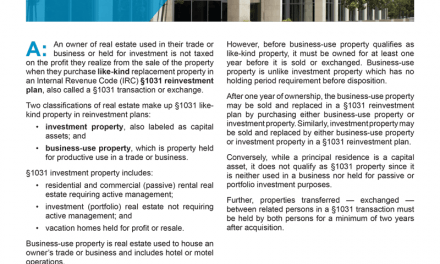This article examines the income and profit reporting for the seller-in-foreclosure when the price received for the property is less than the balance due on loans encumbering the property and the loans are paid off at a discount.
The lender’s discount: income, profit, or loss?
An owner whose residence is now in foreclosure purchased it for the price of $450,000 with a down payment of $25,000. The remaining $425,000 of the purchase price he paid was funded by a fixed-rate, purchase-assist loan covered by default insurance, called private mortgage insurance (PMI).
The homeowner’s cost basis in the residence is the $450,000 price he paid, plus transactional costs he incurred to acquire the property. When the property sells, through a broker or by foreclosure, his cost basis will be subtracted from the net sales price, called the price realized by the Internal Revenue Service (IRS). The difference between his cost basis and net sales price is the profit or loss he takes whether he resells the property or disposes of it by foreclosure or a deed-in-lieu.
The residence was purchased at the peak of the previous real estate boom. Due to the cyclical decline in real estate values following the excessive, speculator-driven rise, the owner’s residence is now worth $300,000. However, while the monthly mortgage payments have remained the same, the owner’s combined household income from bonuses and wages has declined. Nearly all of the homeowner’s disposable income is now consumed by payments on the loan. Thus, the owner can no longer afford to make those payments.
Editor’s note — The same reduction of a household’s disposable income occurs for homeowners who experience an increase in the dollar amount of monthly installments when payments for a negative amortization adjustable rate mortgage (ARM) loan (euphemistically called a subprime, toxic, or speculator’s loan) reset, while at the same time the homeowner is receiving normal pay raises.
The loan balance is now $400,000, an amount far greater than the current market value of the property.
The owner lists the residence with a broker in an attempt to sell it and get out from under the excess debt. As agreed with the broker, any purchase agreement entered into will be subject to the lender’s acceptance of the net sales proceeds as the payoff amount and full satisfaction of the loan, colorfully called a short sale contingency provision. [See first tuesday Forms 274 and 150-1]
The broker taking the listing understands that since the fair market value (FMV) of the residence is below the outstanding debt encumbering it, he must, as additional effort required to sell the property, negotiate with the lender for a discount on a loan payoff demand, called a short payoff. If the lender agrees to accept a short payoff by discounting the amount due to fully satisfy the loan, the property will have gone through what has become known as a “short sale.”
The income tax issue confronting the seller when reporting the sale of his principal residence to the IRS and the California Franchise Tax Board (FTB) is whether the amount of the discount is reported:
- as a reduction in his cost basis, which produces either a reduced capital loss or a profit, with any profit being excluded from taxation by the home profit exclusion of $250,000 per homeowner; or
- as discharge-of-indebtedness income taxable at ordinary income tax rates.
During tax years 2008-2012, for all properties other than a principal residence, and for all other loans but a purchase-assist or refinance limited to the purchase-assist debt on a principal residence, the debt discharged will be subject to ordinary income tax rates unless the loan has nonrecourse status. After tax year 2012, discharge-of-indebtedness income on all properties, whether or not they are principal residences, will be subject to regular income tax rates depending on its recourse or nonrecourse status.
The short sale and accompanying discount
A short sale is a sale of property that:
- generates net proceeds for the seller in an amount less than the total amount(s) owed on the loan(s) of record; and
- the lender accepts the seller’s net proceeds from the sale in full satisfaction of the loan(s).
The difference between the principal balance on the loan and the lesser amount of the net sale proceeds accepted by the lender in exchange for its canceling the trust deed note is called a discount, an arrangement more commonly called a short payoff.
If the broker is initially unable to negotiate a short pay (discount) with the lender, the seller will make no further payments, if he has not already ceased doing so. Thus, the lender is forced to foreclose and cancel the debt if it fails to arrange a compromise before the foreclosure sale, called a pre-foreclosure workout, loan modification, or short pay.
Most lenders require the seller to default on payments for at least three months before they will consider a discounted payoff to accommodate a short sale. A default in payments is the step taken by the owner to exercise the “put option” he holds, a contract right inherent in all trust deed loans. The put option allows the owner to force the lender to buy the property through the foreclosure process (or consider a compromise) should the lender refuse a deed-in-lieu. [See first tuesday Form 406]
The broker’s ability to successfully negotiate a short payoff with the lender depends in part on the type of loan that encumbers the seller’s property.
If the loan is an FHA-insured loan on an owner-occupied, single family residence, the lender may only accept a short payoff if the owner qualifies for FHA pre-foreclosure sale treatment. To qualify, the homeowner must be in default on at least three months’ payments, in addition to meeting other financial ability requirements. [HUD Mortgagee Letter 94-45]
Likewise, if the loan is a conventional loan covered by PMI, the lender’s willingness to negotiate a short pay will be influenced by the lender’s ability to settle their claim with the private mortgage insurer to cover the lender’s loss on the short payoff. Much documentation on the seller’s solvency (hardship) and the property’s value (by a comparable market analysis) must be produced for analysis by the lender. [See first tuesday Form 318]
The discount reduces the homeowner’s basis
Consider the seller-in-foreclosure who owes $400,000 on the purchase-assist trust deed loan encumbering his residence. The property’s FMV is $320,000. The original purchase price, and thus the seller’s cost basis, is $450,000 (plus closing costs).
The seller has received information by an advertisement that implies he will incur taxes at ordinary income tax rates on any discount taken by the lender on the sale or foreclosure of the property, called discharge-of-indebtedness income by the IRS.
The ad then claims the homeowner will avoid the tax liability resulting from income generated by the discount on a short sale if title to the property is transferred to the person offering the service, called a coordinator.
The coordinator offers to take title to the real estate subject to the foreclosure and either:
- complete or arrange a short sale of the property himself; or
- allow the lender to foreclose against the coordinator’s title for nonpayment of installments.
Does the advertisement correctly represent the homeowner’s tax reporting and tax liability exposure from a short sale handled by whomever takes title subject to the loan?
No! The short sale of an owner-occupied one-to-four unit residential property encumbered by a purchase-assist or improvement loan, called a nonrecourse loan under California anti-deficiency law, does not trigger IRS reporting of ordinary income by the seller for the discounted and discharged portion of the loan.
For reporting discounts on purchase-assist and improvement (nonrecourse) loans, the owner closing a sale of his principal residence after January 1, 2007 and on or before December 31, 2012 no longer adds the amount of the lender’s discount to the price paid by the buyer to set the price realized — as was the rule since the 1930s.
Instead, the discount on purchase-assist and home improvement loans, in this case $80,000, is now deducted from the seller’s cost basis ($450,000) to establish an adjusted cost basis of $370,000. Thus, the sale produces a capital loss of $45,000 — the price realized ($325,000) minus the owner’s adjusted cost basis ($370,000). This capital loss is personal (principal residence) and cannot be used (written off) to reduce taxable income.
This tax result is congruous with the prior tax reporting rule on a short sale: the discount is not reported as discharge-of-indebtedness income and produces a personal loss on the sale. [Internal Revenue Code §108(e)]
Discounts on refinancing or equity loans
The accounting for a discount on a short payoff of a loan that refinanced a purchase-assist or improvement loan is very different. Consider an owner who originally purchased his principal residence for $450,000, taking out a $425,000 purchase-assist loan. He later refinances the property for $525,000. The $100,000 in funds received in excess of the loan payoff is not used to improve the property. Thus, the owner’s cost basis in the property remains at $450,000 after the refinancing.
Further, the refinancing is a recourse (deficiency) loan that carries with it different tax consequences than the owner’s original purchase-assist and improvement loans that were nonrecourse (antideficiency) loans.
Editor’s note — Equity loans and refinancing are always recourse loans under California’s anti-deficiency law. The net proceeds from these loans do not themselves finance the owner’s purchase or improvement of the one-to-four unit residence that, in whole or in part, he occupies as his principal residence. [Calif. Code of Civil Procedure §580(b)]
The residence’s current FMV is now only $325,000. Further, the owner is no longer able or willing to make his monthly mortgage payments.
The owner hires a listing agent who sells the property for $325,000. Eventually, a short payoff with the lender at a discount of $200,000 is negotiated by the agent.
Unlike purchase-assist and improvement (nonrecourse) loans on a principal residence, the amount of the discount on the refinancing (recourse) debt is not first subtracted from the homeowner’s cost basis to determine the seller’s profit or loss on the short sale price. Instead, the portion of the refinancing greater than the amount of the homeowner’s purchase and improvement loans paid off by the refinancing ($100,000) is reported as discharge-of-indebtedness income, limited to the amount of the discount.
Thus, $100,000 of the discount is taxable as discharge-of-indebtedness income at personal income rates. The remaining discount amount of $100,000 is then excluded from the owner’s gross income.
However, the remaining $100,000 amount of the discount excluded from income is then subtracted from the owner’s cost basis ($450,000), as in the case of discounted purchase-assist and improvement loans. [IRC §108(h)]
Editor’s note — Had the property been sold before January 1, 2007, the entire amount of the discount ($200,000) on the recourse loan refinance would have been reported as income and taxed at a rate of up to 35%.
Recourse loans taxed as income after 2012
The preferential federal tax reporting currently available for a discounted payoff of both nonrecourse and recourse loans based on the amount of purchase-assist and improvement loans will not be allowed on short sales of real estate involving recourse loans after December 31, 2012. No portion of the discount on a recourse loan will be subtracted from the owner’s cost basis nor be included in the price realized.
Editor’s note — This lenient tax reporting originally applied to any discharge-of-indebtedness income forgiven in calendar years 2007 through 2009, but was extended through 2012 by the Emergency Economic Stabilization Act of 2008. [IRC §108(h)]
California partially adopted the federal principal residence discharge of indebtedness in September of 2008, however, the California rules limit the discharge-of-indebtedness income to:
- debt discharged in a short sale closed in 2007 or 2008; and
- a maximum debt discharge of $250,000 for purchase-assist loan amounts up to $800,000 (or, for married individuals filing separately, a maximum discharged debt reduction of $125,000 for purchase-assist loan amounts up to $400,000). [Calif. Revenue and Taxation Code §17144.5]
Instead, the recourse loan discount will be reported after 2012 as gross income, as it was reported before January 1, 2007. Thus, the owner will not even be entitled to the 15% (capital gain) to 25% (recapture of depreciation gains) tax rate on profit for that portion of the discount representing a portion of the original purchase-assist or improvement loans. Instead, the full discount will be taxed at ordinary income rates (10% to 35% in 2008).
When a short sale occurs after December 31, 2012 on real estate encumbered by a recourse loan, the seller will incur a tax liability at ordinary income rates on the discount reported by the lender on an IRS 1099 Form, which is labelled discharge-of-indebtedness income. Conversely, when a nonrecourse debt is discounted on a short sale, the seller’s tax liability, if any, will still be on any profit taken on the price realized. That price realized will be set as the principal amount of the nonrecourse loan without concern for the discount or the property’s FMV. This rule currently applies to property other than the principal residence. [Revenue Regulations §1.1001-2(a)(2)]
For example, an owner’s property is encumbered by a $400,000 trust deed loan. The loan is a recourse debt that exposes the owner to a deficiency judgment if the value of the secured real estate becomes less than the amount of the debt. The real estate is now worth only $300,000, $100,000 less than the loan amount, which is the deficiency. However, the owner’s cost basis in the real estate is $450,000.
The owner sells the real estate on a short sale. The net amount the buyer pays for the real estate is $300,000. The lender accepts the net proceeds from the sale as a short payoff and in full satisfaction of the recourse note. The remaining unpaid balance of $100,000, the discount, is forgiven by cancellation of the note since the lender does not judicially foreclose as is first required to pursue a deficiency judgment against the borrower. However, the lender must report the discount to the IRS.
The owner’s tax consequences, calculated based on both the sale of the property and the discount of the recourse loan, include:
- a capital loss of $150,000 ($300,000 price received from the buyer minus the $450,000 owner’s cost basis); and
- a discharge-of-indebtedness income of $100,000 ($400,000 loan amount minus the $300,000 price realized and paid to the lender), reported as ordinary income.
Again, since the owner’s cost basis is greater than the sales price and the property sold is the owner’s principal residence, the resulting capital loss is a personal loss. Since it is not a loss on property that falls within an income category due to its personal nature, it cannot be written off to offset the taxation of other income — specifically the discharge-of-indebtedness income. Not so for business use or income/investment property short sales.
After December 31, 2012, a discount on the payoff of a recourse loan (refinancing) encumbering a principal residence will result in taxable discharge-of-indebtedness income. Ironically, this income produced by the short sale of the principal residence cannot be offset by the capital loss produced by the same principal residence on the sale. The loss is classified as personal. [Vukasovich v. Commissioner of Internal Revenue (9th Cir. 1986) 790 F2d 1409; IRC §165(c)]
Discount reporting for investor-owners
The new tax reporting rules in effect until December 31, 2012 only apply to the short sale of the owner’s principal residence. Discount reporting for the short sale of investor-owned property is still controlled by treasury regulations.
For an investor, the debt discharged by a discount of a loan paid off on a short sale of property other than the investor’s principal residence will be a recourse loan producing discharge-of-indebtedness income, unless the investor:
- assumed a nonrecourse loan;
- executed a carryback note secured by the property when acquired; or
- executed a note containing an exculpatory clause releasing the investor from any personal liability.
When the discount is on any type of nonrecourse loan, the investor’s discharged debt will be added to the price the buyer pays for the property, setting a price realized at the amount due the lender. Thus, the discount becomes a profit taxed at capital gains rates, not income taxed at personal income rates. [Rev. Reg. §1.1001-2(a)(2)]
Judicial foreclosure on a recourse loan
Whether real estate encumbered by a recourse loan is lost to the lender in a foreclosure sale or sold to a buyer under a purchase agreement, the owner has disposed of the property. Thus, both situations should produce the same tax consequences; however, they often do not due to the amount of the lender’s bid and the type of foreclosure process the lender uses when the owner exercises his put option by defaulting.
Consider a judicial foreclosure sale of real estate encumbered by a recourse loan. The lender is awarded a money judgment for the deficiency in value on completion of the sale since the FMV of the property at the time of the judicial foreclosure sale is insufficient to satisfy the outstanding principal balance on the recourse loan.
The investor-owner reports the amount of the lender’s bid at the judicial sale (plus the amount of any liens with priority) as the price realized on his loss of the property through foreclosure. [Aizawa v. Commissioner of Internal Revenue (1992) 99 TC 197]
To calculate his profit or loss from the foreclosure sale, the investor subtracts his remaining cost basis from the price realized, which is the high bid at the judicial foreclosure sale since the loan is recourse in nature. [Rev. Regs. §§1.1001-2(a)(2), 1.1001-2(a)(4)(ii), 1.1001-2(c) Example 8]
As long as the deficiency judgment remains unpaid, the owner will not incur any tax liability for discharge-of-indebtedness income that is represented by the amount of the judgment. However, if the lender later cancels the deficiency judgment or allows it to expire (ten years), discount consequences apply.
An alternative of great importance to a seller, such as an investor, faced with discharge-of-indebtedness income on a recourse loan, now or after 2012, is to avoid a short sale, and thus a short payoff, by forcing the lender to foreclose and acquire the property. Lenders nearly always foreclose by a trustee’s sale.
Further, lenders at a trustee’s sale usually bid in the property for the amount of all monies owed them, regardless of the property’s present market value. Thus, they have been fully satisfied by their bid without a discount or uncollectible amount remaining due from the owner. Thus, there is no discharge-of-indebtedness income.
Listing brokers, take note. You are duty bound to care for and protect your client-seller from adverse consequences known to the broker or his agent. Also, consider a §1031 transaction that transfers the over-encumbered property to another person who is willing to deal with the over-encumbered position in exchange for receiving some cash (or other inducement – sweetener) on the exchange.














Bob Frey: While we do not explicitly name the 2007 Economic Stimulus, we do make reference to it in the editor’s note explaining the 2008 changes to the 2007 enactments.
jb: The current suspension of the bonding requirement is reported in our educational materials, and also in our January 2009 article “The EP bonding requirement is void until re-legislated”.
this is related to foreclosure. The courts have suspended the required bond for real estate agents to help investors buy pre forclosed property. The bond was twice the value of the property but now that is in limbo until legislators pass a new bill. This should be clarified in the first tuesday education material.
Hi Bob~
It can be quite confusing but I hope this excellent article available on the CAR website helps, refer to Q9.
http://www.car.org/legal/2008articles/taxation-foreclosures-shortsales/
Best,
Desiree
Keller Williams Realty~Oakland/Piedmont
Doesn’t the economic stimulus bill that was passed on 12-22-2007 eliminate taxation on forgiven debt in real estate for a limited period of time. I did not see that mentioned in the article.
Bob Frey
510-220-8459
I just stopped by your blog and thought I would say hello. I like your site design. Looking forward to reading more down the road.